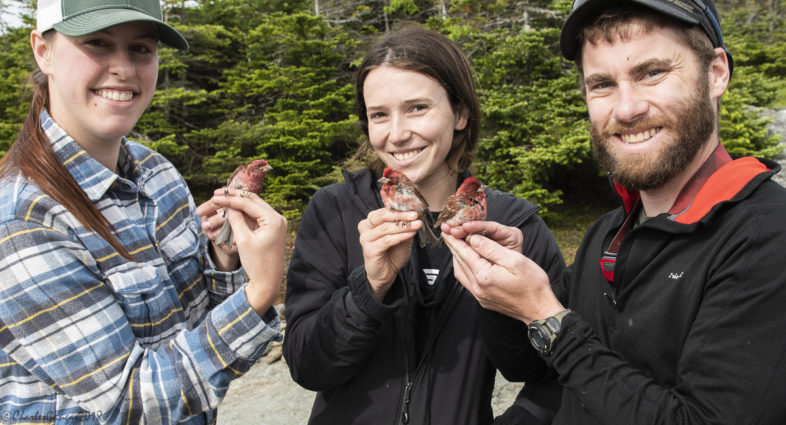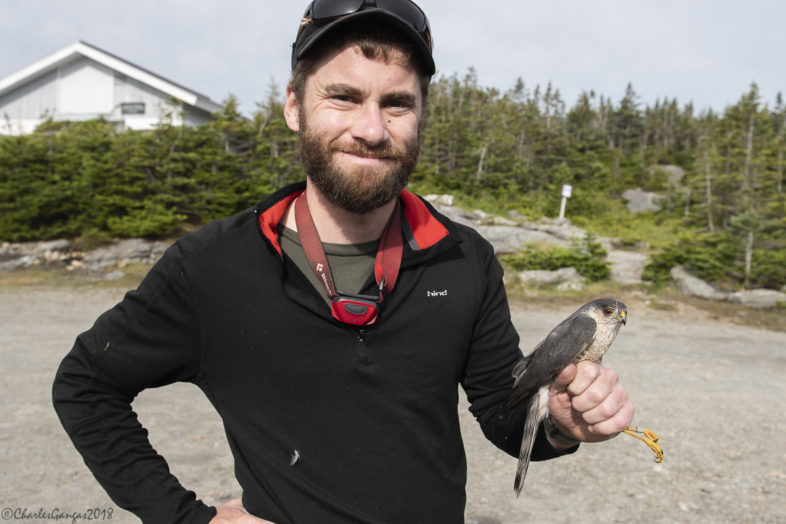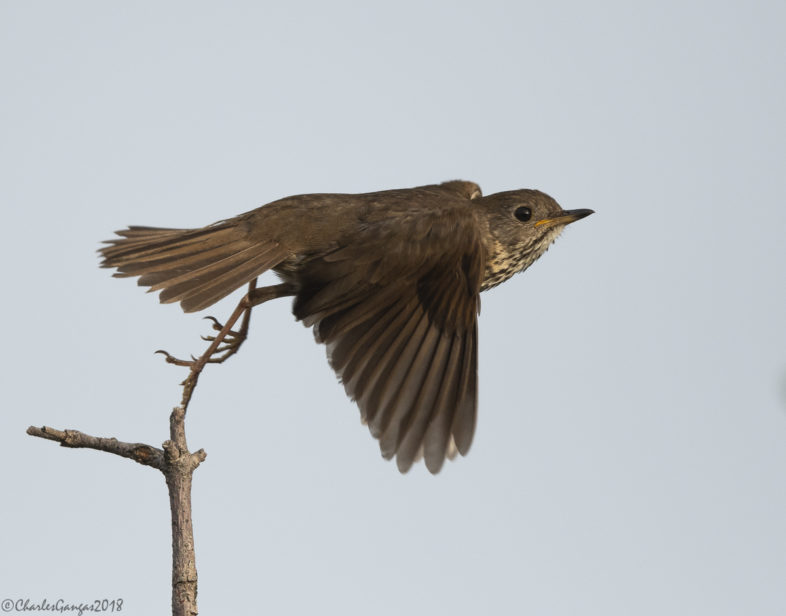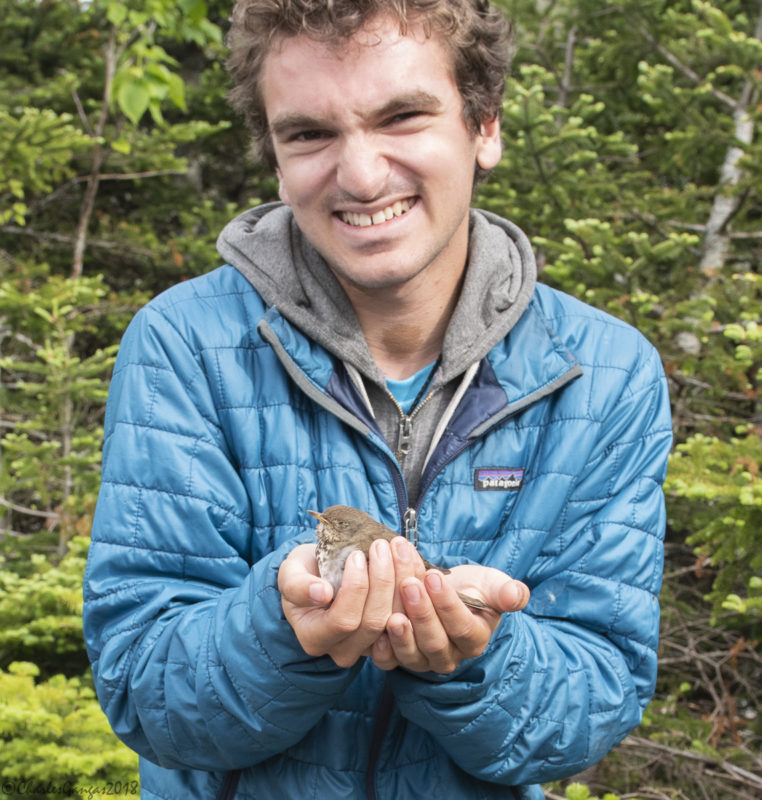
A trio of banded male Purple Finches (PUFIs in banding lingo) awaits release on Mt. Mansfield. From left: Liza Morse (VCE AmeriCorps member), Tara Rodkey (VCE Alexander Dickey Conservation Intern), Tim Duclos (VCE seasonal Conservation Biologist). Photo courtesy of Chuck Gangas.
VCE reached the halfway mark of our 2018 field season on Mt. Mansfield on 26-27 June, completing our fifth banding session on Tuesday evening and Wednesday morning. We ran 25 nets under favorable conditions — mostly calm, cool temperatures, filtered sun. Both sunset and sunrise were spectacular. Overall, singing was reduced from earlier in the month, though Am. Robins, White-throated Sparrows and Purple Finches (PUFIs) were in full voice. I’m quite certain we’ve never encountered as many robins and finches up there as we have so far this year, with 10 and 11 adults banded, respectively. Pine Siskins are still present in good numbers, with a flock of 30 birds roaming around the uppermost parking lot on Wed. morning. We finally captured 2 Magnolia Warblers, our first of the season, and we netted our (more or less) annual Sharp-shinned Hawk. No real surprises this week. Still no Winter Wrens, and numbers of both Swainson’s Thrush and Yellow-rumped Warbler seem relatively low.

Tim Duclos with a banded adult male Sharp-shinned Hawk prior to release. Photo courtesy of Chuck Gangas.
We’re on course for a “typical” or above-average Bicknell’s Thrush (BITH) year, with 40 captures so far, of which 21 are new bandings and 19 birds banded in previous years. Reflecting, at least in part, last summer’s absence of red squirrels (major nest predators that follow cone crop cycles) on the ridgeline, and presumed solid 2017 nesting success by BITH and other open-cup nesting species, our captures of new birds are dominated by yearlings (second-year, or SYs), which accounted for 19 of our 21 new bandings. As always, the sex ratio is skewed towards males (22 vs. 12 females among birds of known sex), reflecting the chronic imbalance that occurs in this species, with its strange polygynandrous mating system.

A Bicknell’s Thrush launches itself from a song post on Mt. Mansfield, 27 June 2018. This unique photo is courtesy of Chuck Gangas.
Our next visit will be on July 10-11, at which point I expect we’ll see and capture juveniles of early-breeding species like robins, juncos, white-throats, and PUFIs. We’ll also likely capture more dispersing failed and non-breeders from lower elevations, and some early-molting adults. It’s hard to believe our field season is halfway to completion!
Among the 62 birds we captured over both days:
Sharp-shinned Hawk — 1 new adult male
Yellow-bellied Flycatcher — 1 new adult of unknown sex
Red-breasted Nuthatch — 1 free-flying juvenile, flight feathers completely grown
Ruby-crowned Kinglet — 1 within-season retrap male
Bicknell’s Thrush — 15 (3 new SY males, 1 new SY female, 3 returns [1 from 2014, 2 from 2016], 8 within-season retraps)
Swainson’s Thrush — 2 (1 new SY male, 1 within-season retrap female)
American Robin — 2 new, male and female
Magnolia Warbler — 2 new males
Blackpoll Warbler — 10 (5 new, 1 return from 2017, 4 within-season retraps)
Black-throated Blue Warbler — 1 new adult female
Yellow-rumped Warbler (Myrtle) — 2 new yearling females
Dark-eyed Junco (Slate-colored) — 5 (4 new birds, 1 within-season retrap)
White-throated Sparrow — 7 (1 new, 6 within-season retraps)
Purple Finch— 5 (1 new female 1 new SY male, 2 new and 1 retrap ASY males)
Pine Siskin — 7 new birds (1 adult female, 6 free-flying juveniles)
As always, the people who participate in VCE’s weekly banding sessions add immensely to our experience. This week’s visit featured a “skeleton crew” — with a very rare absence of visitors — including our seasonal bander Tim Duclos, ECO AmeriCorps member Liza Morse, Alexander Dickey Conservation Intern Tara Rodkey, and UVM summer intern Alex Kulungian. While we missed the excitement and interactions of a crowd, the relative calm afforded Tim and me a chance to work closely with Liza, Tara and Alex, all of whom are eagerly learning the intricacies of mist netting and banding birds.

VCE’s summer intern Alex Kulungian, from UVM’s Rubenstein School of Natural Resources, with a banded Bicknell’s Thrush on Mt. Mansfield. Photo courtesy of Chuck Gangas.

Your doing a great job Alex we are so proud of you God bless you
👵👴
Great photos. I’ve been to Mt M. a couple of times to see/hear the BITHs and brought a friend on our week-long bird tour of VT. Thanks for all your team does.